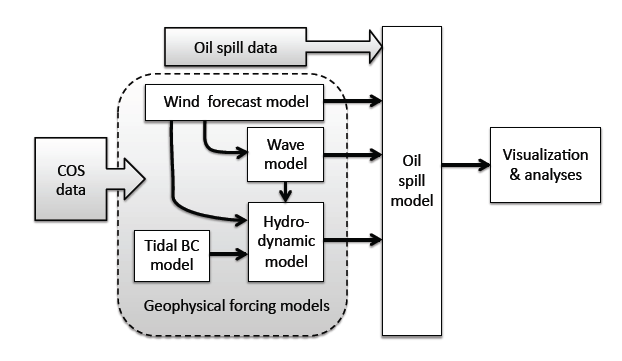Operational oil spill modeling: from science to engineering applications in the presence of uncertainty
ABSTRACT: Quantifying uncertainties in real-time operational oil spill forecasts remains an outstanding problem, but one that should be solvable with present science and technology. Uncertainties arise from the salient characteristics of oil spill models, hydrodynamic models, and wind forecast systems, which are affected by choices of modeling parameters. Presented and discussed are: (1) a systems-level approach for producing a range of oil spill forecasts, (2) a methodology for integrating probability estimates within oil spill models, and (3) a multi-model system for updating forecasts. These technologies provide the next steps for the efficient operational modeling required for real-time mitigation and crisis management for oil spills at sea.
EXTRACT: Figure 1.

Fig. 5.1. General structure of an oil spill forecast system. Geophysical models typically require data from a coastal observation system (COS). River inflow forecasts can be considered part of typical COS data. Individual components are discussed in text.
EXTRACT: Figure 5.6

Fig. 5.6 HyposPy visualization of forecast tracks, continued from Fig. 5.5. Forecast tracks in the second day (0000–1200) are moving consistently closer to the beach. Visualization using Google Earth
ACKNOWLEDGMENTS: The work of X. Hou and B.R. Hodges is based upon work supported by the Research and Development program of the Texas General Land Office Oil Spill Prevention and Response Division under Grant No. 13-439-000-7898 and in part by a grant from BP/The Gulf of Mexico Research Initiative. A. Orfila and J.M. Sayol would like to thank the support fromMICINN through Project CGL2011-22964. J.M. Sayol is supported by the PhD CSIC-JAE program cofunded by the European Social Fund (ESF) and CSIC.
